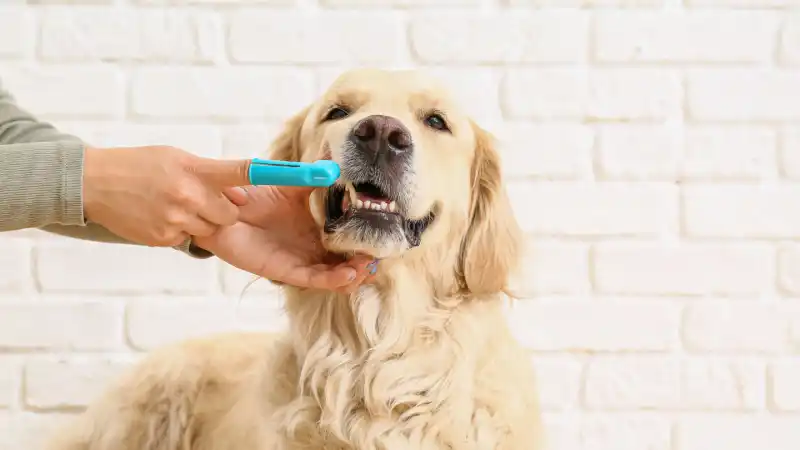Dog Ear Infection Symptoms, Prevention, and Treatment
Dog ear infections are a common reason for vet visits. Learn the symptoms of ear infections in dogs, plus how to prevent and treat them with help from your vet.

Whether floppy, upright, mismatched, or bat-like, our dogs’ ears are part of what makes them unique and adorable. While they are expressive enough to tell us how dogs feel, ears can’t always tell us when they are fighting an infection. Ear infections in dogs are more common than you might think. Though easily preventable, ear infections are the second most common reason for dog vet visits.
Springtime is a common time for canine ear infections to crop up, especially otitis externa or infections involving the exterior aural (ear) anatomy. Rainy days, increased allergens, springtime baths, and trips to the lake all contribute to a higher incidence of ear infections in dogs. Warmer temperatures and humid weather are also the perfect breeding ground for ear infections.
Let’s take a look at other common causes of dog ear infections, symptoms to watch out for, and ways to prevent infection.
What Causes Dog Ear Infections
Infections can occur in the inner (interna), middle (media), or outer (externa) ear. Cause and ear “style” (short, cropped, pendulous) typically play a role in the type of infection contracted by your dog. Most ear infections in adult dogs are caused by bacteria and yeast growth, which result in inflammation, infection, and pain. Puppies can also experience ear infections, but puppy ear infections are typically due to mites or are related to growth. It’s less common for adult dogs to develop ear infections from mites.
Some dogs are more prone to ear infections than others, but all dogs are at risk. Breeds with an abundance of ear hair or floppy (pendulous) ears, like bloodhounds, are at a higher risk due to the propensity of the ear to trap dirt, moisture, and excess wax.
Dogs that suffer from skin allergies (atopic dermatitis) are also at a greater risk. About 50% of dogs with skin allergies will develop ear infections at some point in their lives. Also at risk are dogs who frequent the pool or natural bodies of water. Water can get caught in the inner ear and cause bacterial growth.
Does My Dog Have an Ear Infection?
Dog Ear Infection Symptoms
Symptoms of an ear infection can range from subtle to dramatic depending on the location and the severity. The most common sign of an ear infection is incessant scratching and head shaking. Once the infection has progressed, there is often a distinct accompanying odor that most dog owners with ear infection experience will immediately recognize.
Common symptoms include:
Scratching at ears
Rubbing ears on the ground or furniture
Foul, yeasty odor from ears
Shaking/tilting head
Redness and swelling in and around ear
Moisture or yellow discharge from ear
Scabs from scratching in or around ear
Loss of balance
Loss of hearing
If an ear infection has progressed beyond the initial stages, your dog may also whimper or yelp when they scratch their ears due to pain.

Every Dog and Cat Deserves the Pet Insurance of Champions
Get prize-winning care for your pets.
What to Do if You Suspect an Ear Infection
If your dog is exhibiting any of the above symptoms and you suspect an ear infection, you should call your veterinarian. Your vet may make a diagnosis based on a physical exam or need to take a sample for a diagnosis.
Getting a sample is quick and painless. Your veterinarian will use a cotton-tipped applicator to swab the inside of the ear and will examine the sample under a microscope.
If your veterinarian determines the ear infection is minor or in the early stages, they may just recommend a medicated ear cleaning solution for you to use at home. Your vet or veterinary technician will demonstrate how to clean your dog’s ear with the solution.
If the infection is more severe or chronic, your vet may also recommend medicated ear drops. Canine ear drops are typically administered two to three times a day for a minimum of one to two weeks.
Dogs are typically tolerant of receiving ear drops, especially if given a treat. More severe or persistent canine ear infections may require oral antibiotics, but this isn’t common for most dogs.
Persistent or untreated ear infections can lead to deafness in dogs, so it is important for you to address any symptoms sooner rather than later. Improper or excessive use of ear drops can also be harmful to your dog, so be sure to stick to the recommended dosage and avoid causing additional discomfort to your dog.
Finally, it is critical that you never use
human ear cleaners or ear drops on your dog unless recommended by your veterinarian. Hydrogen peroxide is also never recommended, since it can leave water behind in the ear canal, ultimately making the infection worse. For best results, stick to vet-prescribed ear cleaning products.
Preventing Ear Infections in Dogs
Rather than treating ear infections, you can prevent them! Adding an ear cleaning routine to your grooming and bathing regimen can help prevent ear infections. If you have a breed that is more prone to ear infections, cleaning may have to be more frequent. Another good prevention method is consistently drying the inside of your dog’s ear after swimming or bathing. Simply use a towel and/or cotton ball to dry out the ear before the moisture has time to fester.
Before implementing an ear cleaning routine, have your veterinarian or vet tech demonstrate how to clean your dog’s ears. Using the wrong technique or cleaning too often can damage your dog’s ear canal. Never use a cotton-tipped applicator (or “Q-Tip”) when cleaning your dog’s ears unless otherwise advised by your veterinarian. Dog ears are shaped very differently than the human ear and cleaning too deeply can cause damage to the eardrum.
Don't let ear infections keep you and your dog from enjoying the great outdoors as the weather warms up. Instead, take a few simple steps to ensure your pup’s ears stay clean and dry while still having a great spring season**.**
The information provided in this blog is intended for educational purposes only and should not serve as a substitute for the professional medical advice of your veterinarian. Always consult your veterinarian with questions about your pet’s health and before initiating any treatment regimes.
Take some of the stress out of pet ownership with Accident & Illness Coverage from AKC Pet Insurance (underwritten by Independence American Insurance Company). Our pet insurance plans are designed to be there when you need them, allowing you to focus more on the health of your pet and less on costly veterinary bills.

Every Dog and Cat Deserves the Pet Insurance of Champions
Get prize-winning care for your pets.

Erin Tursam comes to AKC Pet Insurance with a background in veterinary medicine. As the Marketing Manager at PetPartners, she uses her knowledge and experience to help pet owners better understand the health needs of their pets and how pet insurance can help keep them happy and healthy. Erin lives in Apex, NC and has a 13-year-old Cavalier King Charles Spaniel and 7-year-old Doberman.
READ MORE ARTICLES

